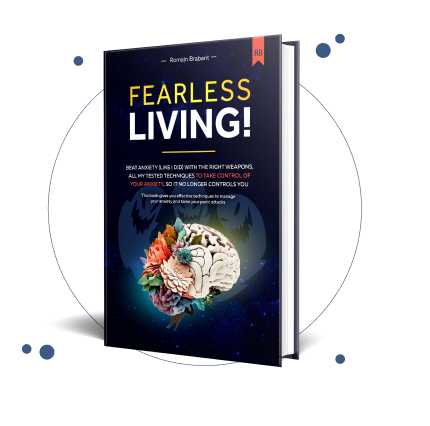
Cognitive restructuring is a fancy term for a simple, yet powerful idea: you can learn to notice, question, and ultimately change the negative thoughts that fuel your anxiety. Think of it less as therapy and more as a practical, hands-on skill for healing. It’s about replacing those anxious, often irrational, thoughts with ones that are more balanced, realistic, and hopeful.
Your Path from Anxiety to Hope Starts Now
Feeling trapped by a relentless cycle of anxious thoughts can be incredibly isolating. It often feels like you're fighting a battle no one else understands, and it's easy to lose hope.
But you are not alone in this, and more importantly, there is a clear and achievable path toward healing. This guide isn't about clinical jargon; it's a set of practical, life-changing tools designed to help you regain control and discover a sense of lasting calm and freedom.
The core message here is one of genuine hope. Healing from anxiety isn't just a distant possibility—it's a skill you can learn and master. Countless people have used these exact strategies to completely rewrite their relationship with anxiety, moving from a state of constant worry to one of empowered peace. Your own story of healing can start today.
Proven Success and a Brighter Future
The power of these methods isn't just wishful thinking; it's a proven pathway to a brighter, panic-free future. Cognitive Behavioral Therapy (CBT), which leans heavily on cognitive restructuring, has shown remarkable success.
Studies consistently show that CBT helps achieve recovery rates of 50-60% for those with major depressive and anxiety disorders. In fact, a significant portion of patients—around 53%—experience full remission after just 12-16 therapy sessions. These aren't just numbers; they represent real people finding real, lasting relief and reclaiming their lives from anxiety.
"The greatest weapon against stress is our ability to choose one thought over another." – William James
This quote perfectly captures the heart of cognitive restructuring. It's about recognizing the incredible power you already have to influence your own mind and create a more peaceful inner world.
To give you a clearer picture of how this works in real life, let's look at some common anxious thoughts and how we can reframe them with hope.
Common Anxious Thoughts vs Balanced Alternatives
This table breaks down how typical anxious thoughts, often driven by cognitive distortions, can be challenged and transformed into more realistic and helpful perspectives. This is the first step toward lasting freedom.
| Automatic Anxious Thought | The Underlying Distortion | A Balanced, Restructured Thought |
|---|---|---|
| "I completely bombed that presentation. I'm going to get fired." | Catastrophizing & All-or-Nothing Thinking | "I stumbled on one slide, but the rest of the presentation went well. I can ask for feedback to improve for next time. It's highly unlikely I'd be fired over one small mistake." |
| "My friend hasn't texted back in hours. They must be angry with me." | Jumping to Conclusions (Mind Reading) | "They could be busy, in a meeting, or just taking a break from their phone. There are many reasons for a delayed response that have nothing to do with me." |
| "I feel so anxious about this party. I'm just socially awkward and everyone will notice." | Emotional Reasoning & Labeling | "Feeling anxious doesn't mean I am awkward. I can focus on talking to one or two people I know. It's okay if I don't stay for the whole night." |
| "I should be able to handle all this stress on my own without any help." | "Should" Statements | "It's normal to feel overwhelmed sometimes, and it's a sign of strength, not weakness, to ask for support when I need it." |
Seeing these side-by-side shows just how powerful a simple shift in perspective can be. It's about moving from an automatic, fear-based reaction to a more considered, evidence-based response—a skill that will serve you for a lifetime.
Taking the First Step
We're going to move beyond theory and dive into actionable strategies that you can apply in your daily life. You'll learn how to tackle the deep-seated worry that often comes with conditions like overthinking, a topic we explore more deeply in our guide on the connection between overthinking and anxiety.
While cognitive restructuring is a powerful tool on its own, many people find that combining it with other natural approaches enhances their progress. If you're looking for complementary strategies to support your journey, you might find a practical guide to reducing anxiety naturally to be a valuable resource.
Your journey toward a life with less panic and more peace begins now—with the very first step of understanding your own mind.
Getting to Know Your Anxious Mind

Before you can change your anxious thoughts, you have to get to know them. Think of your mind as a well-worn path in a forest. Over years of walking the same route, your brain creates mental shortcuts—automatic ways of thinking that you no longer even notice.
These mental habits, known in psychology as cognitive distortions, are often the silent engine driving anxiety and panic.
The goal here isn't to beat yourself up for having these thoughts. Everyone does. The goal is one of compassionate self-discovery. True self-awareness is the first, and most crucial, step toward realizing you have far more control than you think. Once you can name the pattern, you can start to dismantle its power and reclaim your peace.
This whole idea of spotting and challenging automatic thoughts isn't just a hunch; it's the core of Cognitive Behavioral Therapy (CBT). This approach was pioneered by psychiatrist Aaron T. Beck back in the 1960s. He found that when people learned to identify and question their own distorted thinking, their emotional distress dropped significantly. To dive deeper into this, you can learn more about how CBT helps manage anxiety in our detailed guide.
Common Thinking Traps That Fuel Anxiety
Let's break down a few of the most common cognitive distortions. Recognizing these in your own life is a powerful sign you're making progress, not a reason to feel bad. It's a key step on your path to healing.
- Catastrophizing: This is the classic "what if" spiral. You send a work email and your mind immediately jumps to the worst-case scenario: "My boss will hate this, I'll get a terrible review, and I'm definitely getting fired." You've leaped from a tiny event to a full-blown catastrophe.
- Black-and-White Thinking: This trap forces you to see everything in extremes—it's either all good or all bad. If you aren't a runaway success at something, you feel like a complete failure. There’s no room for shades of gray or just being "good enough."
- Mind Reading: You're convinced you know what other people are thinking, and it's almost always negative. Before heading to a party, you might think, "Everyone there is going to find me so awkward and boring." You're treating a wild guess as a cold, hard fact.
The moment you become aware of a thought, you are no longer the thought. You are the one observing it. This simple shift creates the space you need to change.
These thought patterns can feel intensely real in the moment, but they're just that—patterns. They are not unshakable truths about you or the world. Learning to spot them is like flicking on a light switch in a dark room. Suddenly, you can see the furniture and find your way out. This awareness is your starting point for building a life free from the grip of panic.
Becoming a Detective of Your Own Thoughts
This is where things start to shift. Right here, you begin to take an active role in your own healing by learning how to catch those fleeting, anxious thoughts the moment they pop up. This isn't about fighting them—it's about getting curious.
Think of yourself as a compassionate detective of your own mind. The goal is to gently observe your thoughts, not to judge or criticize them. When you can do that, you start to see them for what they are: just temporary mental events, not facts. This simple shift in perspective is the foundation for real, lasting change and a more hopeful future.
The Power of Gentle Observation
The first move isn't to wrestle your anxious thoughts into submission. It's simply to notice them. You're just gathering clues, not building a case against yourself. An anxious thought is just one piece of information, not the whole story.
The second you can step back and think, "Huh, that's an interesting thought," you create a tiny bit of space between you and the anxiety. That space? That's where your power is. It’s where the healing starts.
This image below really captures the essence of this process. It shows how those sharp, distorted thoughts can be softened and reshaped with a bit of mindful awareness.

The big takeaway is that you don't need to force anything. All it takes is gentle attention to start smoothing out those rough mental edges and letting hope in.
Simple Ways to Start Catching Your Thoughts
You can put this into practice right now with a couple of incredibly simple methods. Remember, consistency is what matters here, not intensity. Every small step forward is a victory.
-
The 3-Minute Thought Check-in: A couple of times a day, just set a timer for three minutes. Sit quietly and ask yourself, "What's on my mind?" Let the thoughts come and go without trying to fix or change them. Just notice.
-
The "Anxiety Log" on Your Phone: Use a notes app to quickly jot down anxious thoughts as you become aware of them. Don't analyze them yet—just capture the raw thought. A quick note like, "Worried I'll mess up the meeting tomorrow," is a huge win.
The most powerful question you can ask when you feel that familiar knot of anxiety is this: "What story am I telling myself right now?" This simple prompt helps you see that thoughts are just narratives—and you have the power to write a new one.
Every single time you log a thought, you're building a muscle. You're training your brain to notice its own automatic, unhelpful habits. This isn't about giving yourself more work; it’s about creating more freedom. Each thought you catch is another piece of proof that you are in control, and that a life without constant anxiety isn't just a nice idea—it's completely within your reach.
How to Gently Question Anxious Thoughts
Once you’ve spotted an anxious thought in the wild, the next step is to gently disarm it. This isn't about starting a fight with your own mind or forcing yourself to "just think positive." That approach rarely works and often leads to more frustration.
Instead, think of this as becoming a compassionate advocate for your own well-being. You're going to introduce a few calm, powerful questions to investigate whether your fears are actually telling the truth. This is how you reclaim your power.
This idea isn't new. In fact, its roots stretch back roughly 2,000 years to Stoic thinkers who taught that our perception of events—not the events themselves—shapes our emotional state. Its modern form took shape in the mid-20th century with pioneers like Albert Ellis, who showed how irrational beliefs fuel our distress. You can discover more about the historical journey of these powerful ideas on ncbi.nlm.nih.gov.
Becoming a Compassionate Investigator
The key here is your tone. You are not an aggressive prosecutor trying to prove your thought wrong. You are a kind, curious investigator simply seeking the truth. This gentle approach lowers your internal defenses, making it much easier to see a situation clearly and find a more hopeful perspective.
Let’s walk through a common scenario to see how this works.
The Anxious Thought: “I’m going to make a huge mistake on this project, and my boss will think I’m incompetent.”
This thought is a classic, likely fueled by common thinking errors. For a deeper understanding of these patterns, check out our complete guide on identifying and challenging cognitive distortions.
Now, let's apply our gentle questions to dismantle this fear and open the door to peace.
Powerful Questions to Dismantle Fear
Here are some go-to questions you can use to challenge the anxiety and guide your mind toward a more balanced, hopeful perspective.
-
Where is the hard evidence for this thought?
- “What facts support the idea that I will make a huge mistake? Have I made similar mistakes often in the past? What does my actual performance history show?” This moves you from feeling to fact.
-
Is there any evidence that contradicts this thought?
- “Can I think of times when I completed projects successfully? Have I received positive feedback from my boss before?” This actively seeks out a more balanced view.
-
What is a kinder, more realistic way to view this situation?
- “It’s possible I might make a small error, as everyone does. But it's more likely I'll complete it well, just like my other projects. Even if there's a mistake, it's an opportunity to learn, not a sign of incompetence.”
-
If the worst-case scenario happened, how would I cope?
- “If my boss was disappointed, I would ask for specific feedback, correct the error, and focus on the next task. It would be uncomfortable, but I know I would survive it.” This question proves that even the worst case is manageable.
The goal isn't to erase all doubt but to introduce a more reasonable, hopeful, and truthful alternative. By asking these questions, you are not just fighting anxiety; you are actively building a new, more supportive relationship with yourself.
This practice is a cornerstone of cognitive restructuring. Each time you gently question a fear, you weaken its hold and strengthen your own sense of calm and capability. It is a profound act of self-care that proves, time and again, that you have the power to guide your mind toward peace.
Building and Living Your New Beliefs

Challenging your anxious thoughts is like pulling weeds. You've cleared the ground. Now it's time to plant something new—balanced, compassionate beliefs that actually support you. This is where the real work of building a panic-free life begins.
This isn’t about forcing yourself to believe things that feel fake or slapping on a coat of toxic positivity. It's about carefully crafting new thoughts that feel authentic and true, turning abstract ideas into your lived reality and creating the foundation for lasting hope.
Crafting Your New, Balanced Thoughts
Think of your new belief as a direct, compassionate answer to your old anxious thought. It needs to be believable, kind, and grounded in the evidence you’ve already gathered.
Let’s look at an example:
- Old Thought: "I'm so awkward in social settings, and everyone can tell."
- New Belief: "I sometimes feel anxious in social situations, but that's a feeling, not a fact about me. I can handle a short conversation, and it's okay if it isn't perfect."
See the difference? The new belief doesn't deny the anxiety. It just puts it in its place. It acknowledges the feeling while affirming your ability to handle it. This is where the shift from panic to freedom really starts.
The goal isn’t to silence fear, but to give the voice of reason and hope a microphone. You're building a new internal dialogue that serves you, creating a foundation of self-trust one thought at a time.
This powerful shift is a central goal in professional therapy. For those curious about structured support, understanding the role of psychotherapy for anxiety can shed light on how therapists guide this exact process.
Testing Your Beliefs in the Real World
A new belief is just a theory until you test it. This is where you prove to yourself, through small, deliberate actions, that your new way of thinking is valid. In cognitive behavioral therapy, we call these behavioral experiments.
This isn't about facing your biggest fear all at once. It’s about taking small, manageable steps designed to collect real-world proof that your new, healthier belief is true. This is what makes the new mindset stick and turns hope into reality.
Here’s how you can put this into practice:
-
Start with your new belief. Let's use, "I can handle a brief, low-stakes chat without it being awkward."
-
Design a tiny, safe experiment. What’s one small action you could take to test this? It should feel low-risk and achievable.
- Example: "I'll ask the barista how their day is going when I get my coffee."
- Example: "I'll give a simple compliment to a coworker on their presentation."
-
Predict the outcome. What does the old anxious voice predict will happen? (e.g., "They'll think I'm weird and brush me off.") What does your new, balanced belief predict? (e.g., "It will probably be a normal, brief interaction.")
-
Run the experiment and observe. Go do the thing. Pay attention to what actually happens, not what your anxiety tells you is happening.
-
Reflect on the results. So, what was the actual outcome? Did the catastrophe you feared come to pass? Most of the time, you'll find reality was much closer to your balanced prediction.
Each time you do this, you collect another piece of evidence. This evidence reinforces your new, healthier mindset and chips away at the old fear, one small experiment at a time. This is how you heal.
Your Questions on Cognitive Restructuring Answered
Starting to rewire your thoughts is a huge act of self-care. It’s also completely normal to have questions and hit a few roadblocks along the way. This isn’t a sign of failure; it's a sign you're digging deep and doing the real work of healing.
Let’s tackle some of the most common questions that come up. Think of this as a friendly chat to clear up any confusion, boost your confidence, and keep you moving forward. You're building life-changing skills, and you deserve to feel capable and hopeful every step of the way.
What if a Thought Feels Too True to Challenge?
This is probably the biggest hurdle. An anxious thought like, "I'm just not a confident person," can feel less like a thought and more like a core part of who you are. When a belief is that deeply ingrained, trying to argue with it feels pointless.
So, instead of a direct fight, try a gentler, more hopeful approach. Start by asking, "Is this belief 100% true, 100% of the time?" The answer is almost always no. That tiny crack of doubt is your starting point—it's where the light gets in.
From there, you can start exploring the exceptions: "Can I think of one time, even a small one, where I acted with a bit of confidence?" Maybe you spoke up in a meeting, or tried a new recipe, or gave a friend good advice.
This method isn't about proving the thought completely wrong overnight. It's about showing yourself that it isn't an absolute, unchangeable fact. Each exception you find chips away at the old belief and starts building a case for a new, more compassionate one. This is how gradual, lasting healing happens.
How Long Does This Take to Actually Work?
I get it. When you're struggling, you want to know when you'll feel better. While there’s no magic number, the good news is that people often start feeling a sense of relief and hope relatively quickly—sometimes within a few weeks of consistent practice.
The very first change you'll likely notice isn't that the anxiety is gone, but that you have a growing awareness of your thought patterns. This awareness is a massive win. It gives you a choice where you once felt powerless, and this is the first real taste of freedom.
Lasting change comes from consistent practice, not perfection. Think of it like building muscle at the gym. The results from cognitive restructuring are cumulative. Every small effort builds on the last, creating a foundation of resilience and calm that gets stronger over time.
True, deep-rooted change—where balanced thinking becomes your new default—can take several months. But the journey is full of small wins that keep you going. For a better sense of how this fits into the bigger picture of healing, you might find it helpful to read about the broader anxiety recovery steps.
Am I Doing This Right?
It’s so easy to get caught up wondering if you're practicing these techniques "correctly." Here’s the most important thing to remember: if you are trying, you are doing it right.
There's no single "correct" way to restructure a thought. The whole point is to move from a rigid, negative viewpoint to one that is more flexible, balanced, and kind.
Whether you use a thought record, ask yourself probing questions, or just gently say, "There might be another way to see this," you are succeeding.
Progress isn't a straight line. You will have days where anxious thoughts feel like a tidal wave and other days where you feel clear and in control. This is the natural rhythm of healing. Celebrate the effort, not just the outcome, and trust that you are on a path toward a life with less panic and more freedom. You can do this.
The journey to a calmer mind is one of the most rewarding you can take. To support you with a clear, step-by-step framework, The Anxiety Checklist provides a complete system to help you put these principles into action. It combines a detailed eBook with an interactive checklist to guide you from understanding your anxiety to building a life of fearless living. Learn how to beat anxiety and live your best life with The Anxiety Checklist.

